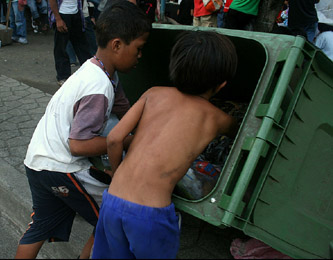
This photo was taken in 2009 as two children in Davao City rummage through a trash bin to look for something to sell. (davaotoday.com file photo)
DAVAO CITY — The Department of Labor and Employment (DOLE) has identified only 398 child laborers in Davao Region, a sharp drop from the estimate of 114,000 in 2011.
DOLE 11’s Profiling of Vulnerable Workers in 2014 has identified 310 child laborers that time. However, the survey was done in only 25 barangays in the region which was believed to have the most number of children in labor situation. The region has a total of 1,267 barangays as of 2010, according to the Philippine Statistics Authority.
However, Kriztia Marie Labrador, labor and employment officer, said that DOLE cannot give the exact data of the children who are involved in child labor. She said, as of now, DOLE aims to spread awareness to people the disadvantages of child labor.
Under DOLE’s child labor prevention and elimination program, it has extended livelihood assistance worth P1.7 million in 2015 for 398 parents of identified child laborers.
DOLE said a National Statistics Office 2011 survey estimated 3.028 million children were in child labor conditions. The Philippines has 29.019 million population in the age group 5-17 years old.
“Out of the 3.028 million, approximately 114,000 child laborers are from Davao region,” Labrador said.
Labrador said that the issue of child labor has two factors, the cultural and economic aspect.
“Before, child labor is part of the culture and not a problem to a city or country, it was accepted by the society that a child will work especially if the family is not financially stable to earn money,” Labrador said.
DOLE said that most child labor occurs in the informal sector, of which 60 percent comes from the agriculture sector.
Agricultural work includes production of sugarcane, bananas, coconuts corns, hogs, rice, rubber and tobacco.
Florie May B. Tacang of Kaugmaon, a Davao-based child rights group also reported that some children work through scavenging, vending and doing loading service in public market and fishing industry.
“Their working conditions are such that they are exposed to great harm physically, socially and morally,” she said.
End child labor
DOLE, together with Kaugmaon, Act for Children Alliance and Davao Organizations of Youth Against Child Labor announced this year’s observance of the World Day Against Child Labor with the theme “End child labor—it’s everyone’s business,” on June 12, 2016.
The observance was started by the members of the International Labor Organization (ILO) in 2002 to bring attention to the people all over the world, the global extent of child labor.
Prior to the observance, Labrador said that DOLE would have a forum on child labor in supply chains on Friday, June 10, at The Ritz Hotel at Garden Oases, Porras Street here.
Bernardo Mondragon, of the Act for Children Alliance, called on the concerned agencies to address the issue on child labor.
“We enjoin the government and stakeholders in the private sector to take the necessary measure to stop the participation of children in the production of good and services, especially those working in conditions that are demeaning to their human dignity and depriving them of their childhood,” Mondragon said. (davaotoday.com)










